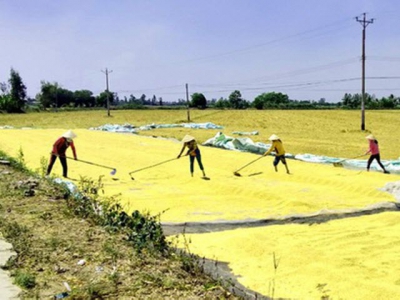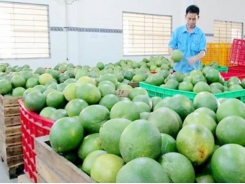Farmers in Mekong Delta provinces enjoy bumper winter-spring rice crop

On the last days of February, farmers in the Mekong Delta have entered the peak harvest season of the winter-summer rice crop. Despite the impacts of saltwater intrusion and drought on coastal areas, most farmers have enjoyed a bumper crop and the price of paddy has also increased compared to at the beginning of the crop.
Rice harvesting in Can Tho City. (Photo: SGGP)
Experts said that the global rice supply declines due to the impacts of climate change, the price of rice will benefit farmers in the Mekong Delta.
Mr. Tran Anh Tuan, a farmer in Long My District in Hau Giang Province, said that he had just finished harvesting rice then sold fresh paddy to traders for VND5,000 per kilogram at the field. He was so happy as this price was VND300 per kilogram higher than that at the beginning of the rice crop. His one-hectare rice field got productivity of nearly 7 tons per hectare.
Mr. Tuan is one of the thousands of farmers in Long My District who have just harvested around 500 hectares of winter-spring rice. The farmers like Mr. Tuan was happy when the local authority mobilized nearly 100 combine harvesters to help farmers to simultaneously harvest their rice. The rental of a combine harvester fluctuated from VND260,000-VND300,000 per 1,000 square meters, depending on the condition of paddy, standing or falling, lower than the cost for manual harvesting which was from VND400,000-VND500,000 per 1,000 square meters.
Currently, farmers in the Mekong Delta have harvested around 750,000 hectares out of 1.5 million hectares of winter-spring rice with the yield of around 6.8 tons per hectare, or around 5 million tons of paddy. Although some coastal areas were threatened by saltwater intrusion, the Government, the Ministry of Agriculture and Rural Development, and provinces actively carried out several measures so the damage was insignificant. Of which, the fact that farmers grow rice earlier to avert drought and saltwater intrusion has shown its effectiveness. Besides, the fact that provinces also finished key works to prevent saltwater intrusion early and operated them timely has protected the rice-growing areas.
Currently, local enterprises are buying wet paddy at VND4,400-VND5,400 per kilogram, VND300-VND500 per kilogram higher than that at the beginning of the crop; only the price of the IR50404 rice variety for the domestic market is low, at VND4,400 per kilogram. Of which, the price of long-grain paddy is higher than normal paddy by VND300-VND800 per kilogram. The price of paddy bought at the warehouses of enterprises is from VND5,400 to VND6,400 per kilogram, higher than the price of fresh paddy sold at the field by an average of VND1,000 per kilogram.
The prices of paddy have increased sharply when farmers entered peak harvest season. particularly, many traders and enterprises went to the fields of farmers to deposit and sign underwriting contracts, collecting long-grain paddy at VND5,000-VND5,200 per kilogram, and VND6,000-VND6,100 per kilogram for the RVT rice variety alone. Especially, the ST24 rice variety fetched up to VND7,100 per kilogram. More importantly, the rice yield was estimated at 7.3-7.5 tons per hectare, said Mr. Tran Chi Hung, Director of the Department of Agriculture and Rural Development of Hau Giang Province.
This year, global rice production is forecast to slightly drop from 499 million tons to 497.8 million tons. According to the US Department of Agriculture, the global trade and consumption this year are expected to climb to 46.2 million tons of rice, an increase of nearly 2 million tons compared to last year. Rice exports of Vietnam are forecast to edge up slightly to 6.75 million tons compared to the level of 6.7 million tons last year.
After being the largest rice importer of Vietnam for more than 10 years, in 2019, China fell to the fourth place because of changes in tariff policies, tighter control on the quality of rice, along with a high inventory of rice.
However, rice experts said that rice reserves of China will run out after the end of the Covid-19 outbreak. Therefore, rice imports in China will increase significantly. Meanwhile, besides traditional markets, the export of rice of Vietnam is expected to be more optimistic when the EU-Vietnam Free Trade Agreement not only helps to increase the export turnover of Vietnam but also to improve the competitiveness of Vietnamese agricultural products in the European market. The Vietnam Food Association said that this year, rice exports of Vietnam are expected to be promising thanks to the positive impacts of new-generation free trade agreements, as well as changes in the supply and demand of the global market. With policies on the interest rate cut, Vietnam actively works with the Philippines on the export of rice, at the same time intensifying control on healthy competition among domestic enterprises, to widen the doors for the export of rice of Vietnam.
At the present, severe drought and saltwater intrusion not only affect the remaining area of winter-spring rice but also the production of the upcoming summer-autumn rice crop. Enterprises concerned that if farmers grow rice for the summer-autumn rice crop late, the production and the quality of rice will be affected. According to the MARD, drought and saltwater intrusion will continue to last for a long time, so provinces in the Mekong Delta should continue to implement solutions to protect the production of farmers.
Many institutes and universities in the Mekong Delta have researched and produced salt-tolerant rice varieties for local farmers. Lately, the High Agricultural Technology Research Institute of the Mekong Delta has tested around 68 rice and glutinous rice varieties. Scientists appreciated some rice varieties for their quality and their salt and drought tolerance. By actively applying various measures to tackle drought and saltwater intrusion, only 30,000 hectares of winter-spring rice were affected or damaged in various degrees. The figure for damage is merely equal to one-seventh of the historic drought and saltwater intrusion in 2016.
Có thể bạn quan tâm
Phần mềm

Phối trộn thức ăn chăn nuôi

Pha dung dịch thủy canh

Định mức cho tôm ăn

Phối trộn phân bón NPK

Xác định tỷ lệ tôm sống

Chuyển đổi đơn vị phân bón

Xác định công suất sục khí

Chuyển đổi đơn vị tôm

Tính diện tích nhà kính

Tính thể tích ao hồ



 Safe farm develops from polluted dump
Safe farm develops from polluted dump  VietNam 's agro-forestry-fishery exports drop 2.8 per cent…
VietNam 's agro-forestry-fishery exports drop 2.8 per cent…